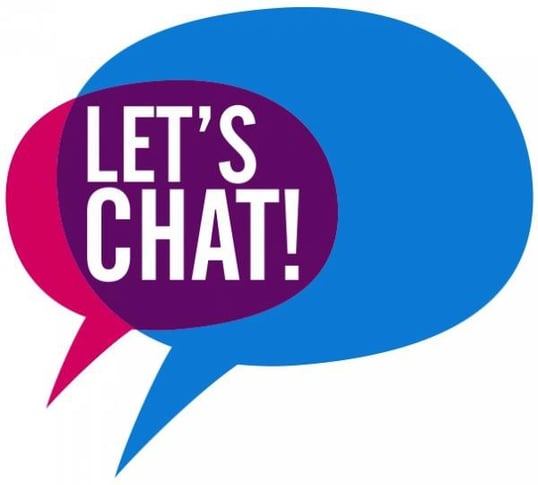Yes, chatbots are here! But what is a chatbot? How can businesses use them? And more importantly, should your business use them?
Chatbots are Not New
The very first chatbot, ELIZA, was created over half a century ago. Surprised? 2016 marked the 50th anniversary of ELIZA’s creation by a team at MIT. An early natural language processing computer program, ELIZA was developed in 1966 at the MIT Artificial Intelligence Laboratory to demonstrate the superficiality of communication between humans and machine. Ironically, ELIZA’s creators were surprised by the number of individuals who attributed human-like feelings to the computer program. Other notable chatbots since ELIZA, include SmarterChild, who in the early 2000’s developed intimate friendships with over 30 million Instant Messenger users on AOL and MSN; and of course, there’s IBM’s Watson who in 2011 competed on and won Jeopardy!
If Chatbots are Vintage, Why the Sudden Renewed Interest?
There are four major trends that have come together to make what’s old new again:
Trend #1 — Era of Mobile: As a society, we have never before experienced this level of connectedness. The convenience of smartphones and tablet devices, coupled with the innovation in mobile technology mean that we are always reachable and always reaching out. Times have been changing—and doing so rapidly. Today, the vast majority of Americans—95%—now own a cellphone of some kind and 77% own a smartphone (up from just 35% in 2011). And, what’s more, we’re spending 2 out of every 3 of our digital minutes on mobile devices.
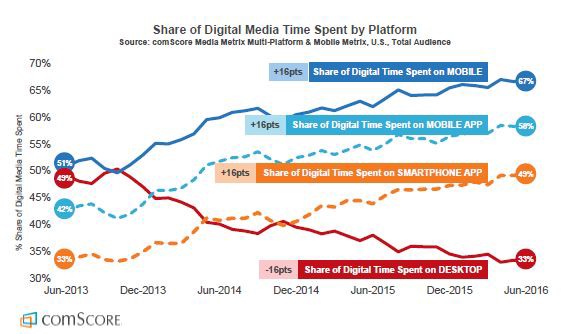
Trend #2 — App Fatigue: While as users, we are spending more time on smartphones, we're also downloading fewer and fewer apps. In fact, over half of all smartphone users now download zero apps per month.
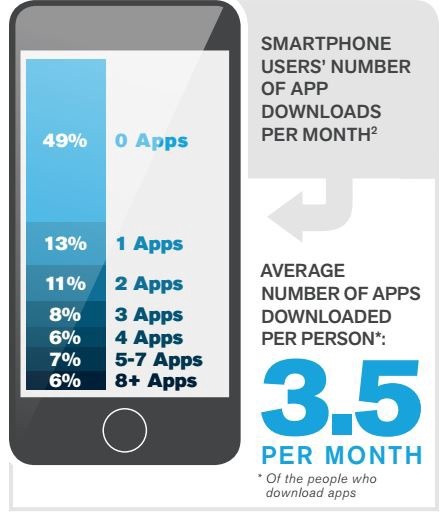
Of the apps that are downloaded, according to a Forrester Research Study, one in four is abandoned after just a single use. For those downloaded apps that remain on their smartphone, the typical user spends the majority of their time in only their favorite five.
Trend #3 — Rise of Messaging Apps: In the past few years, while companies have focused on establishing a presence on social networks (Facebook, Twitter, Pinterest and Instagram), messaging apps (WhatsApp, Facebook Messenger, WeChat and Kik) have surpassed those social networks in terms of the number of active users per month.
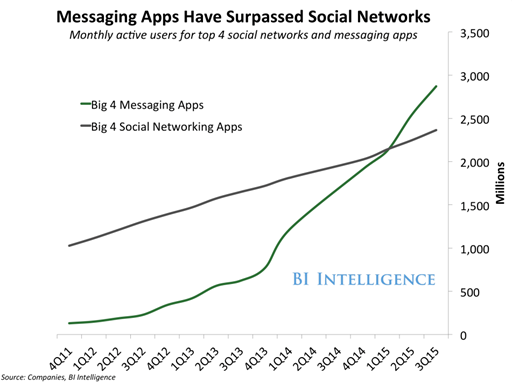
Trend #4 — Artificial Intelligence (AI): According to CB Insights, investments in AI have tripled in the last three years and we are starting to see AI-based products and services, like Amazon’s Echo and Apple’s Siri, become more and more available.
The exploding popularity of messaging bolstered by AI creates an opportunity for companies to connect with their customers like never before and in a way that is contextual, relevant, highly personal and conversational. This is what’s driving the renewed interest in chatbots.
Chatbots of Today
Today's chatbots are software programs. However, unlike software programs such as Word or Excel which have to be installed on your laptop and apps like Instagram or Pokemon Go that are downloaded onto your smartphone, chatbots live on messaging apps such as Facebook Messenger, SMS, Kik, WeChat and others.
Chatbots enable companies to be where their customers are — on messaging.
Brands and companies have been using today’s chatbots for practical purposes such as a customer service tool or to collect information. Why? Because customers no longer need, or want, to speak to a human for simple things like checking store hours or confirming account balances. Today, companies can deliver high-quality customer service and reduce costs by outsourcing basic customer service questions to a chatbot.
Unlike human beings, chatbots never tire at answering the same questions over and over again. 24 hours a day, 7 days a week. Where a person tires or bores, a chatbot excels! How is this possible? To do their job, some chatbots rely on sophisticated natural language processing systems, while others use intelligent rules (i.e. if the person says this, respond with that). And then there are those that use both natural language processing and intelligent rules to get the job done. Keep in mind that today’s chatbot technology is rapidly emerging and continually improving. The chatbots of tomorrow will likely be far more sophisticated and able to handle more complex jobs.
Gartner has predicted that by 2020, 85% of customer interactions will be managed without a human.
To get an idea of how a chatbot works let’s look at one in the real-world. The airline KLM recently introduced a chatbot on Facebook Messenger that, with your permission, allows the chatbot to send passengers their itinerary, boarding pass, check-in confirmation and even delay notifications to their Facebook Messenger. It also gives the ability to talk to a human staff member when they have questions that are outside the scope of the chatbot. It’s quick, convenient and low friction. There is no app to download and nothing new to learn.
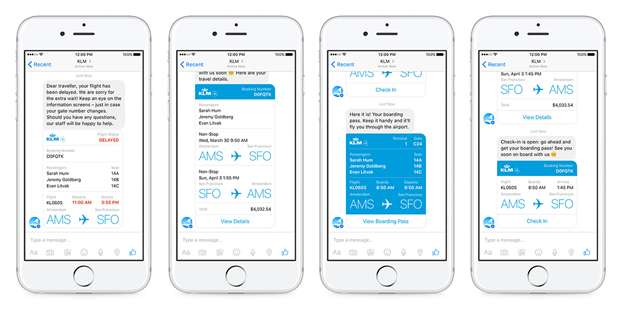
The KLM chatbot is just one example of how chatbots can open up an entirely new world of opportunities for companies to engage with their customers. We are now seeing many companies across different industries experiment with and successfully use chatbots. Here are some of the other early adopters that you can check out to see how they are using chatbots:
- Travel — KLM, Kayak and Hyatt's chatbots help customers book trips, deliver boarding passes and provide concierge services.
- Healthcare —The chatbots of HealthTap and Your.MD are helping people identify illnesses and find healthcare advice.
- Retail — H&M, Sephora and Everlane have created chatbots that customize the shopping experience, including personalized recommendations based on user preferences.
- Fast Food —With their chatbots, Taco Bell and Pizza Hut are reducing wait and delivery times while customers order food without ever leaving their messaging app.
- Grocery — Whole Foods' chatbot helps people find recipes and suggests food products based on the listed ingredients.
- Government — The White House now has a chatbot that assists people contact government officials, including the U.S. president.
Should your business use chatbots?
The potential benefits of chatbots are clear. They are more cost-effective than hiring customer service representatives and have faster response times. They enable easier, more seamless business transactions. And they offer a more convenient way to address prospects and customers in a medium they prefer, while increasing engagement with both prospectives and existing clients or customers.
But does this mean your business should use chatbots?
Here are five opportunities to get you started thinking about how your business could benefit from chatbots:
Opportunity #1 — Always Available: Would you like to expand your customer support hours but face budget and staffing constraints? Good news! Chatbots are economical and can work 24 hours a day, 7 days a week, 365 days a year. And they are always on time, pleasant and never take a personal day!
Opportunity #2 — Ability to Scale: Do you find it challenging to scale your customer service operations during peak times? Do you have an opportunity to expand or grow your business but don’t have the customer support staff necessary to support it? Chatbots facilitate scaling by augmenting your human customer support team. You can use chatbots as the first point of contact to handle basic questions and for triage. This frees up your human agents to address more complex questions and issues. Introducing chatbots in your customer support organization (many) means more customers served!
Opportunity #3 — Answering Frequently Asked Questions: Do your customer support agents answer the same questions about shipping, returns, loyalty programs, store locations, operational hours, etc. over and over again? Chatbots to the rescue! A chatbot is well suited for answering your customers’ frequently asked questions and they never tire of them so each and every one of your customers gets the same high-quality service.
Opportunity #4 — Reaching Millennials: Are you trying to reach millennials and finding it a challenge? You are not alone! The 80 million millennials in the US are the least-engaged generation of consumers; yet, it’s never been more important to reach them. Millennials have an estimated $200 billion in collective buying power — and were projected to have more than any other generation by 2018.
Chatbots can help! According to the 2018 Internet Trends Report, millennials prefer their contact with businesses be text-based communications (like live chat, social media, messaging) over voice; and, they also happen to really like self-service. In fact, 69% of millennials would like to solve customer service issues by themselves without having to talk to anyone in customer service. Chatbots can meet both of these millennial needs: they are both text-based and self-service.
Opportunity #5 — Customer Engagement: Like most companies, you have probably focused on establishing a presence on social networks (Facebook, Twitter, Pinterest, and Instagram) to engage with potential and existing customers. But remember, messaging apps (WhatsApp, Facebook Messenger, WeChat, and Kik) have surpassed those social networks in terms of the number of active users per month. Chatbots live on messaging apps and enable you to be where your customers are and to engage with them in a fresh, new way!
Developing a Chatbot Strategy - Be Intentional
There is no doubt that chatbots are gaining momentum. They will soon be an expected channel for customer support, so it is important to be intentional about your chatbot strategy. Start by identifying:
- What are simple, low risk, but meaningful use cases that you can use to experiment with a chatbot?
- Who are your target customers?
- What messaging app(s) do they use?
- What are your measures for success?
- Who are credible chatbot strategy, development and maintenance resources that you can rely on?
The investment you make in chatbots today will yield greater understanding and improvement over time. The more you know, the better positioned your business will be to leverage the chatbots of tomorrow to engage, connect with and delight your customers!




